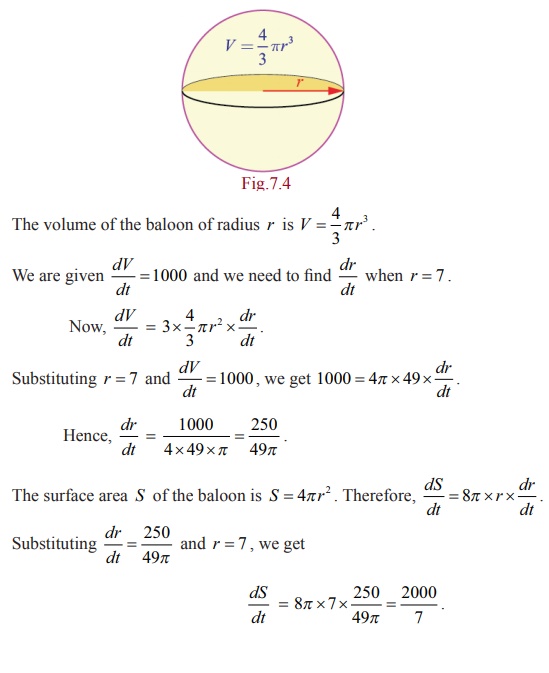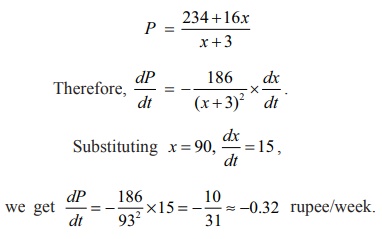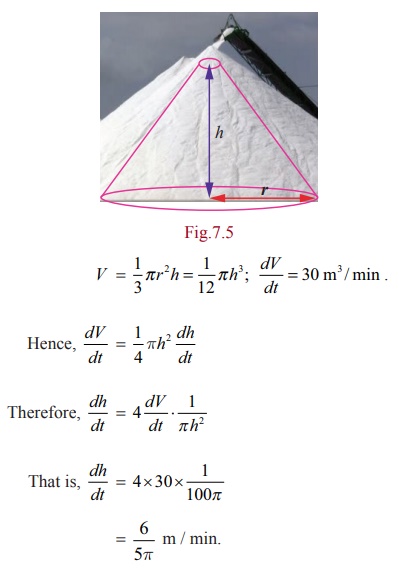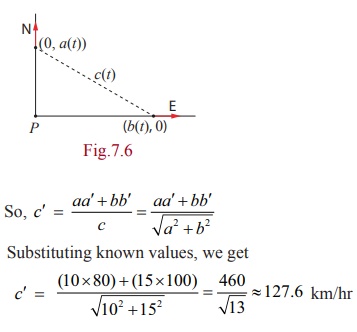Meaning of Derivatives | Mathematics - Related rates | 12th Maths : UNIT 7 : Applications of Differential Calculus
Chapter: 12th Maths : UNIT 7 : Applications of Differential Calculus
Related rates
Related rates
A
related rates problem is a problem which involves at least two changing
quantities and asks you to figure out the rate at which one is changing given
sufficient information on all of the others. For instance, when two vehicles
drive in different directions we should be able to deduce the speed at which
they are separating if we know their individual speeds and directions.
Example 7.7
If we
blow air into a balloon of spherical shape at a rate of 1000 cm3 per
second, at what rate the radius of the baloon changes when the radius is 7cm?
Also compute the rate at which the surface area changes.
Solution

Therefore,
the rate of change of radius is 250/49ŽĆ cm/sec
and the rate of change of surface area is 2000/7 cm2 / sec.
Example 7.8
The
price of a product is related to the number of units available (supply) by the
equation Px + 3P ŌłÆ16x = 234 , where P is the price
of the product per unit in Rupees(Ōé╣) and x is the number of units.
Find the rate at which the price is changing with respect to time when 90 units
are available and the supply is increasing at a rate of 15 units/week.
Solution
We have,
We have,
234+16x / x+3

Substituting x = 90, dx/dt = 15, we get dP/dt =
ŌłÆ 186/932 ├Ś 15= ŌłÆ 10/31 Ōēł ŌłÆ0 .32 rupee/week. That is the price is
changing, in fact decreasing at the rate of ŌĆēŌé╣ 0.32 per week.
Example 7.9
Salt is
poured from a conveyer belt at a rate of 30 cubic metre per minute forming a
conical pile with a circular base whose height and diameter of base are always
equal. How fast is the height of the pile increasing when the pile is 10 metre
high?
Solution
Let h and r be the height and the base radius. Therefore h = 2r . Let V be the volume of the salt cone.

= 5/5ŽĆ m / min.
Example 7.10 (Two
variable related rate problem)
A road
running north to south crosses a road going east to west at the point P . Car A is driving north along the first road, and car B is driving east along the second road.
At a particular time car A is 10
kilometres to the north of P and
traveling at 80 km/hr, while car B is
15 kilometres to the east of P and
traveling at 100 km/hr. How fast is the distance between the two cars changing?
Solution
Let a (t)
be the distance of car A north of P at time t , and b (t) the distance of car B east of P at time t, and let c(t)
be the distance from car A to car B at time t . By the Pythagorean Theorem, c
(t)2 = a (t)2 + b (t)2 .
Taking derivatives, we get 2c (t)cŌĆÖ(t) = 2a (t)aŌĆÖ(t) + 2b (t)bŌĆÖ(t) .

at the
time of intersect.
Related Topics